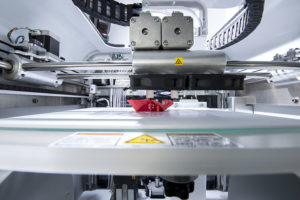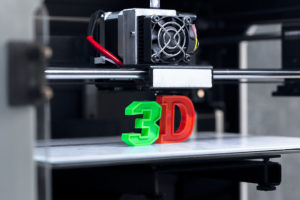Is Additive Manufacturing (AM) the next big disruptive innovation in the construction industry, or is it simply a fad that is perhaps likely to be dismissed as futuristic? Is the HVACR market ready to accommodate 3D printing in mainstream manufacturing or will historic investment in traditional facilities serve as a bottleneck? Lastly, will a market’s
reluctance to acknowledge its evolution stunt its growth, or could it risk evolving regardless, unregulated and untamed? Hannah Jo Uy has the story…
It’s just a belief, but a strong one. You can sense the passion in his voice, when Dr Z Haktan Karadeniz says that 3D printing has the potential to change the very nature of the industry. Dr Karadeniz is Assistant Professor, Department of Mechanical Engineering, İzmir Kâtip Çelebi University in Turkey.

Dr Karadeniz
Elaborating, he asks the listener to imagine an engineering world, where “you can select some base design of a heat exchanger from the library of a BIM software and select a proper place for the equipment in the building façade”. An automated Computational Fluid Dynamics (CFD) application, he says, designs the new duct-line after boundary conditions and analysis tools are confirmed. The cloud computing module, he says, will control the CFD application to maximise the efficiency of the base design of heat exchanger and duct-line. “During that phase,” he says,
“you can select the proper fan for your system from the supplier’s catalogue or software, which is already integrated with the designer’s software.” The software, he says, will then assess and implement the necessary changes to the project to further optimise its efficiency, after which it will process the order and, following confirmation, send the fan dimensions to the 3D printer, either in the fan manufacturer’s facility or on site, in the event a large number of fans have to be produced.
Once the design is approved, Dr Karadeniz continues, data will be sent to the site and simulation of the additive manufacturing process is cross-checked with the software of the ‘3D constructer’ on the site. Finally, he says, a multi-tasked 3D printer, capable of printing a wide range of materials will start the construction. “Oh, wait!” Dr Karadeniz says. “There is no need for ‘you’! This is all a machine and software world connected by an IoT network awaiting a single order, ‘Start’, and single input, ‘Architectural Design’.”
The ‘you’, in the long-term estimation of Dr Karadeniz, is the HVAC professional at any position across the HVAC industry’s value chain, as he presents the possible paradigm shift that Additive Manufacturing can initiate. How far are we from this future?
Where we stand today…

Dr Singer
Dr Farah Singer, Research Associate, Smart and Small Thermal Systems Laboratory, Center for Environmental Engineering, University of Maryland, in the United States, is well acquainted with the uptake of additive manufacturing over the years. Leading the research in heat transfer and additive manufacturing of heat exchangers for different applications, Dr Singer says she has observed growing interest of leading manufacturers in the Center’s recent projects. “Additive manufacturing,” she says, “is evolving very fast, and many high-end companies [have started] using Additive Manufacturing in their [production] line.” She points to General Electric’s (GE) move to enter the market, also saying that NASA has also shown interest recently, using a 3D-printed combustive engine on a real flight.
More and more stakeholders are jumping on the bandwagon. Hamid A. Syed, Vice President and General Manager, UL Middle East, shares the company’s decision to enter the AM space in 2014, “when the transition from prototyping to production started to take shape”. Time to market, cost reduction and mass customisation are some of the benefits AM can offer production, Syed says. Aerospace and medical industries have already been active in this production, he says, and in the past 2-3 years UL has seen additional industry segments emerge.

Hamid A. Syed
“From an HVACR perspective,” Syed says, “in addition to the use of additive manufacturing for part production with energy-efficient designs, there is a great opportunity for replacement parts, tooling, jigs and fixtures.” While 3D-printing technologies have been around for over 30 years, Syed adds, use in mainstream manufacturing is only starting to emerge. “The technology demands of mainstream manufacturing,” he stresses, “are accelerating the innovation in the technology and its relevance in the future of smart manufacturing.”
In terms of uptake, Dr Karadeniz believes that additive manufacturing for high performance and additive manufacturing for integrated design have different time lines. “High-performance components, such as heat exchangers and fans, are already being manufactured by 3D printers,” he says. “Considering the fast growth of additive manufacturing technology and industry in the last two decades, the integration of the 3D printers into the HVAC sector as a trusted manufacturing tool would not take more than 10 years.”
Dr Karadeniz, however, believes that more time is needed for the additive manufacturing of whole HVAC components and units in the mainstream market and for integrated design and 3D building construction. “Energy-efficiency policies, increasing IAQ sensitivity and widening applications of “High Performance Buildings” are pushing the limits of engineering,” he says. “Therefore, the conventional engineering methods, both for design and manufacturing, are becoming insufficient to meet the high performance [requirements].”
Dr Karadeniz says that a change in the understanding of design and processes is imperative to increase efficiency. “However the engineering culture of the HVAC manufacturing industry is deeply connected to the machining and metal fabrication processes,” he says, “for which the resulting designs are mostly repetitive linear structures. These structures are on their limits for the efficiency and far away from being flexible enough to meet the aesthetic needs of an architect.”
The revolutionary change is only a matter of time for the enterprise side, Dr Karadeniz says, However, he adds, 3D printers are considered hobby tools rather than manufacturing facilities, and 3D printing for consumer products is not in the near future perspectives of technology forecasters like Gartner. “I think we will still be buying printed HVAC units instead of manufacturing them at home in the future,” he says.
Syed presents a more conservative approach in view of ensuring quality. “As with any manufacturing application,” he says, “the product lifecycle from design to quality assurance is critical. One of the greatest challenges that industries are facing is ensuring that their workforce is properly trained on the nuances of this technology and how to properly integrate it into their manufacturing value chain.” Syed believes that additive manufacturing is not going to replace all manufacturing techniques. “It is intended to offer a capability, which traditional manufacturing techniques do not currently offer,” he adds.

Uwe Wassermann
Uwe Wassermann, Director AEC Business Development Worldwide, Autodesk, echoes this. “3D printing will develop in the future,” he says.“Today, we see it widespread in different areas with more than a hundred different materials. I think it will always be a combination of traditional and 3D printing. You can print single elements and combine them with modules and bigger components across disciplines.” This, he says, extends to HVACR applications. At the end, he says, proper logistics and assembly must also be addressed. “I believe there will be an evolution,” he says. “In 10 years, maybe, there will be 3D printing [of equipment] onsite, where you can print the whole thing. Today, I think we are so far off from using what is available, we need to first start to adopt the things in the market and, at the same time, be open to further developments.”
Beyond ‘cheap’ – bottlenecks and drivers
Initially, Dr Singer says, cost was a bottleneck in the uptake of AM, with research needed to prove financial benefits. However, she says, things are evolving and 3D-printing machines that used to cost a million US dollars are now available at half the price. “I don’t think it needs more than 2-3 years,” she says, in view of such trends. Despite certain stakeholders being adamant that AM is not a practical solution, Dr Singer says that recent studies in material composition have been able to enhance and optimise the benefits of material printing, which, she says can pave the way for greater adoption.

Tatjana Dzambazova
Tatjana Dzambazova, AI Strategist, Office of the Chief Technology Officer (CTO), chimes in. “We are literally seeing daily drops in price,” she says, driven by both material choice and economies of scale. “The biggest problem with 3D printing is that it’s slow, it’s small and it’s expensive. You want it fast, big and cheaper.” Dr Singer says that despite the fact that the payback is attractive, the manufacturing industry is not considering it immediately owing to its conservative nature and historic investments. As such, she says, it is important to also highlight the whole other spectrum of advantages, such as better quality and higher performance, aside from cost competitiveness, while waiting for prices to lower. “Some industries we are in talks with,” she says, “don’t care about the cost. They would tell us to develop a heat exchanger for the same price but with higher performance. This is a great breakthrough, because they can tell the customer that the heat exchanger can survive 10 years instead of five.”

Chris Matthews
Chris Matthews, Managing Director, Silenceair International, an Australian ventilation company, provides a manufacturer’s perspective. “Customisation is becoming increasingly critical to satisfy architectural and construction demands on projects,” he says. “[To address this] we have established a 3D-printing factory, where we have a large number of 3D printers working 24 hours a day to make customised parts that enable us to provide specialised solutions for our customers. We can now offer solutions, where once we would have walked away. I see a huge potential for this type of technology.” Although 3D printing is still in its infancy, Matthews says, the technology will transform the building industry in the decades to come.
Dzambazova adds that another key advantage of 3D printing is that complex designs are able to be executed, adding that she believes innovations in this field will move in the direction of exploring new types of composite materials with the aim of lowering cost. Dr Singer echoes this, saying that freedom in design, and the ability to specify and control dimensions and size, while increasing performance, also makes a case for AM. Dr Karadeniz admits that while recent 3D-printer technology is very slow for mass production, the issue will be solved as the HVAC industry and other stakeholders define their needs and look towards materials that meet both construction and HVAC standards.
Success underpinned by software and proper regulation
Syed believes that the technology is naturally going to evolve with the demands of manufacturing. “Software and automation tools are being developed inherent to the machine, and additive techniques are being combined with traditional manufacturing techniques in hybrid machines.
We also see industry trends in digital manufacturing and smart manufacturing that are creating a more strategic opportunity for the technology to evolve and be integrated into the factories of the future. It is important to note that as the technology evolves, the benefits and limitations will also evolve.”
Similarly, Dr Karadeniz admits that the future he had envisioned in relation to 3D printing’s role in design approaches, requires the development of relevant background software, network protocols, optimisation algorithms and CFD methodologies. “The need for innovation, research and development, and standardisation will be increasing,” he says. “Besides, machines and software will be the consultants, and they will carry most of the contractors’ load. Constructers can be named as a manufacturer instead. The building owner will be directly connected to the manufacturer, if there is no intellectual property issue for the project or to the architect, if a special building design is needed.”
Most importantly, Dr Karadeniz says, regulations must be developed, accordingly. “The role of the regulators will be more important,” he says. “Although virtual reality lets us travel even into the tiniest pipe before construction, we can revise the design and solve some problems on the way with today’s methodology.” In such a future, he says, while the building owner must trust the machine and software, who will actually be trusted is the certifier or regulator behind the scene. “The result will be certification of the design methodology instead of the product itself,” he says. “The software and 3D printers certified according to the updated regulations will produce high-quality buildings. The highly flexible nature of additive manufacturing will push the limits of the standardisation.”
Dr Singer also touches on the importance of regulation, which she says, currently there is not enough of. “We need regulations,” she says, “and more input on what to validate and what not to validate, and whether, at some point, it would have its own certification for buildings or [as part of] LEED or not.”
Syed adds that in any evolution, new hazards are introduced. “For [AM], there are risks with new materials, the equipment, the production facilities and the final part produced,” he says.
“This technology started as R&D, where compliance with standards and regulations is not as stringent. In the past five years, there have been significant efforts by regulators, standard development organisations (SDOs) and OEMs to align this technology with new and existing standards and regulations.” Innovation, he stresses, will always precede regulations, and as the innovation timelines accelerate in manufacturing, new approaches must be implemented to ensure there is still a level of safety and risk mitigation implemented.
Wasserman points out, however, that the regulations must also be in the context of existing legislative framework developed for the built environment. “At the end of the day,” he says, “you need to meet certain standards, whether you make it traditionally, or with components using 3D printing. If the thing needs to bear a certain load, you need to reinforce. You cannot go around regulations by doing 3D printing. You need
to meet the criteria with any kind of products.” Wasserman admits that it might change in the future, if legislation is amended to reduce certain requirements following a better understanding and recognition of fabrication technology and the quality required. However, he believes it will not serve as a particularly big challenge.
The slow development of international regulations or rules for validation in the field of AM, Dr Singer says, is largely owing to lack of expertise. “AM,” she says, “is going fast. There are a lot of technologies but not a lot of experts.” Additionally, she says, there is a limited number of available educational programmes in the field. The technology, she says, “blew up so fast with new patents and people creating their own machines and techniques”, creating a big gap between advancement of the technology and the skills required to ensure its quality. “We always say we need experts,” she says. In the University of Maryland, Dr Singer says, the department is committed to developing courses to address the need for graduates that have the degree, as well as the theoretical and hands-on knowledge and experience to participate in the development of relevant regulations.
On the subject of training, Syed also provides an update on what UL is doing through its Additive Manufacturing Competency Center (AMCC) training facility, in the University of Louisville. The Center, Syed says, is a catalyst for the continued learning and development of established AM technical and business professionals. “The AMCC provides experiential, peer-to-peer opportunities to transfer cutting-edge, AM-specific knowledge among AM practitioners, academic and corporate researchers, and industry consortia,” he says. The AMCC was designed specifically for end-to-end AM application-based training stressing the importance of safety, he says. Beginning with process and material fundamentals and progressing through design, build planning, process parameters, post-processing and quality evaluation, students will design to manufacture parts, he adds.
Further underpinning the importance of standards and regulation, Dr Singer says that the lack of reliability tests and universal certification also serves as a hindrance for AM products to enter and replace equipment in the existing market. “Even if reducing cost is the goal,” she says, “additively manufactured products won’t make it to the market if not proven reliable and robust enough to survive the required lifetime.” Pointing to the 3D-printed heat exchanger as an example, Dr Singer says it will not replace the conventional heat exchanger ‘until it is proven to give the required performance for the same lifetime as the heat exchangers currently in the market’. “This is due to the fact that faulty or unreliable heat exchangers would leak, break or deteriorate early,” she says, “causing unfortunate problems in the industrial system they’re implemented in and, in some cases, these problems are considered disastrous.”
As such, Dr Singer says that even if there is an uptake in the use of AM among manufacturers, the adoption of the products in the market will only increase in the same pace that reliability, lifetime and ageing test and certifications and standards are developed that will help consumers ascertain that 3D-printed products not only compete but also exceed the function of conventional products currently being used.
Growing pains and 3D printing’s voice in the sustainability dialogue
For Dr Karadeniz, these issues are no different from those that typically plague the new kid on the block. Pointing to Building Information Modelling (BIM) as an example, Dr Karadeniz stresses that it took more than 20 years to move from being conceptual to a real-life application, whereas today, BIM, as a methodology, has become vital for the design, construction and operation of high-performance buildings. Dr Karadeniz believes all components across the HVAC industry’s value chain must be included in the theoretical study for integration of AM, adding that there is room for BIM to further accommodate AM, advocating for a more inclusive dialogue, considering other technological developments, such as cloud computing, IOT and super computers, among others. “Industry 4.0” will not lose the chance to convert the manufacturing methods and also design strategies in HVAC industry,” he says. “Therefore, the role of professionals will be more on the engineering side than on the site.”

Mahesh Ramanujam
Mahesh Ramanujam, President and CEO, US Green Building Council (USGBC), in sharing the Council’s position on 3D printing, says that they recognise the role of disruptive innovation 3D can play in the development of high-performance buildings. “What is the heart of 3D printing?” he asks. “It is to be able to do rapid deployment, rapid development, most importantly, get the design right and get to mass implementation. We clearly see an opportunity for us to do a two-way conversation: 3D driving ‘Green’ and ‘Green’ driving 3D.”
Dr Karadeniz believes that, at the end of the day, a building owner needs a tailor-made living space with a healthy, comfortable and sustainable building. “These will be satisfied with high quality in a shorter time,” he says. “Additive manufacturing will be used for high-performance products during the technology transition. The manufacturing process will be really lean. Raw material that is ready for additive manufacturing will be the input, and any product will be the outcome. Logistics will be easier. Non-linear designs will be producible. A heat exchanger, for example, can be a porous media for which every single pore is perfectly designed for the flow and heat transfer conditions given as a design goal. That will rise the efficiencies to the desired levels.” Such a design, he says, is only possible by an additive manufacturing approach.

3D printing
Speaking on the uptake of new technologies, such as 3D, block chain and AI, all of which the USGBC considers in the pursuit of a healthier built-environment, Ramanujam retraces the journey of low-VOC paint products entering mainstream market. “Twenty years ago,” he says, “when you buy paint you get caustic smell, exposure to chemicals and it harms your cognitive function because of toxins and carcinogens. Today, low-VOC paint was pushed by LEED to the market as a requirement.” In the same manner, he says, 3D printing “can absolutely have a place in LEED and reverse, to push the market to the next level.”
Also, he says, there is opportunity in its acceleration to embed the ethos of sustainability among participating stakeholders in the move forward. “It’s all about promoting best practices around the world,” Ramanujam says, “and we learn from others and we also contribute to their [learning].”

Lynelle Cameron
Lynelle Cameron, CEO of Autodesk Foundation and Vice President of Sustainability Autodesk, weighs in on 3D-printing’s role in the sustainability dialogue in the context of similar emerging disruptive technologies, which she calls the “future of making things”. “This is not just bells and whistles,” she says. “This is how all buildings will be designed. Sustainability is just an inherent part of that, as it enables us to design buildings without the typical 30% waste at the construction site. We have so many buildings being constructed, reducing waste is a key part of that, as well as using new types of materials that can be repurposed and reused after the life of a particular building.” Cameron says this makes a case for circular construction, where “materials are kept in an infinite closed-loop process”.
Dr Karadeniz adds: “All of the components of the HVAC industry will be a part of this change and will evolve to their new roles. After the maturity of the technology, manufacturers will have flexible production lines that they may not even be a dedicated HVAC equipment or system manufacturer. Because they can easily switch between the production of an automobile spare part to an HVAC equipment.” He adds that R&D engineering will be the most important, if not the sole, function remaining from the manufacturers of today. “Discrete engineering tools will be interoperable; therefore, the design process will be smoother,” he says. “Likewise, the HVAC equipment, units and systems. Contractors will be the constructor/manufacturer of the buildings and consultants will be behind the software preparation process.”
Dr Karadeniz admits that there is always a bottleneck towards acceptance of revolutionary changes. However, he believes that the important question to ask is, ‘Do we really need this change?’ “We can continue with the traditional methods and be happy at our homes that were already built by traditional methods,” he says. “However, entrepreneurs always look for opportunities, financiers always look for profit, and engineers always look for challenges.” This, he says, is essentially what forces the overall HVAC sector towards change.
The story of Additive Manufacturing continues to be written, with its feasibility in real-world applications, especially in the HVACR segment, passionately being debated by people from various camps. For both believers and doubters, one thing is for sure – the technology has the potential to have significant implications that could send a ripple effect across current building design practices. How much, or how little, will depend on the respective agendas of stakeholders.
Hannah Jo Uy is Assistant Editor at Climate Control Middle East magazine. She may be contacted at hannah@cpi-industry.com
Copyright © 2006-2025 - CPI Industry. All rights reserved.